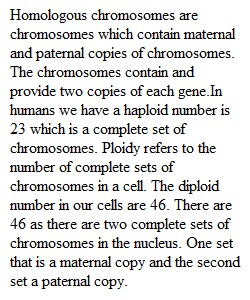


Q Lab 1 – Modeling Mitosis and Meiosis Objective: Answer the questions below, while modeling the process with modeling clay (or playdough), and then demonstrate how Mitosis produces 2 daughter cells that are identical to the parent cell and Meiosis produces 4 daughter cells, each with half the number of chromosomes as the parent cell. You will take 2 pictures of stages of Mitosis, and 4 pictures of stages of Meiosis. Materials: • Blue modeling clay (Roll into multiple 5-inch strips, and 3-inch strips) • Red modeling clay (Roll into multiple 5-inch strips, and 3-inch strips) o (You may use different colors as long as you are consistent and maintain the same color definitions throughout.) • A digital camera. A simple phone camera suffices. Definitions: 1.) Each strip of modeling clay equals one chromosome (Figure 1) a. Red is a chromosome from the organism’s father (paternal chromosome) b. Blue is a chromosome from the organism’s mother (maternal chromosome) c. Chromosome 1 is 5 in. long, Chromosome 2 is 3 in. long Figure 1: The genetic components of your cell prior to replication – this is the setup for your chromosomes at the start of Part 1 and 2 below. 2.) At the appropriate stage, following replication, two strips of the same color and length modeling clay (sister chromatids) are pinched together at the centromere. Part 1: Mitosis In this Part, you are to model mitosis in a somatic cell that has two chromosomes that originated from the organism’s father (paternal chromosomes) and two from the organism’s mother (maternal chromosomes). Figures 11.5 and 11.12 from the textbook may be helpful. Procedure and Questions: 1) Identify the maternal “homolog” for both Chromosome 1 and 2 and then the paternal homologs. Arrange these chromosomes as you would expect to find them during G1 of interphase. a. What are homologous chromosomes? b. What is the haploid number of our cell (n)? What does this refer to? c. What is the diploid number of our cell (2n)? What does this refer to?d. What happens during S of interphase?2) The contents of the nucleus have now just completed interphase and are entering prophase. Arrange the chromosomes as they would appear in prophase. Hint: See Definition 2 on page 1 of this lab and compare your chromosomes to Figure 11.5 in the textbook.a. At this stage, each chromosome consists of b. When is it appropriate to speak of sister chromatids versus a chromosome?
View Related Questions